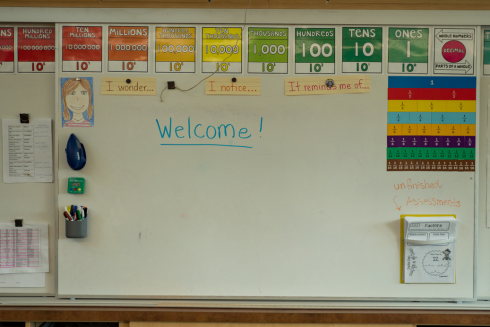 Creating an inclusive, supportive classroom is essential for student success and well-being. And we all know happy students are easier to manage and perform better academically.
Creating an inclusive, supportive classroom is essential for student success and well-being. And we all know happy students are easier to manage and perform better academically.
A positive learning environment starts with an organised, clutter-free space that motivates students. Displaying student work, providing easy access to resources, and fostering collaboration are key, along with clear routines to build trust. But there are many more effective ways to help students feel welcome.
Inclusivity and support
Accommodating diverse learning needs is essential for every learner to thrive. Amber Chandler’s Welcoming All: The Three Cs of Inclusive Education highlights three principles for an inclusive environment: community, communication and consistency. By defining roles and expectations, everyone can contribute, and no one is left behind. Open communication with stakeholders fosters collaboration and reduces misunderstandings, while consistency ensures that routines remain clear.
Nina Parrish’s Ensuring that Instruction is Inclusive for Diverse Learners discusses universal design for learning (UDL), a flexible approach to teaching that benefits all students. UDL encourages presenting content in different formats, such as videos, activities, or demonstrations, to accommodate various learning styles. Providing students choices in how they demonstrate their learning helps sustain engagement, while offering accommodations such as text-to-speech ensures equal access. Teachers should view this not as a burden, but as strategies that keep students engaged and make the day more enjoyable.
Welcoming students with ADHD
Teaching students with ADHD can be rewarding with the right strategies in place. A NSW government article Evidence-Based Strategies for ADHD advises clear communication, breaking tasks into smaller steps, and using visual and verbal prompts. Varying teaching methods helps maintain engagement, while offering students choices and extra help ensures better learning outcomes. Seating arrangements for students with ADHD should minimise distractions, and consistent feedback be used to reward appropriate behaviours. As students succeed and feel understood, their self-esteem and sense of belonging will grow, leading to stronger teacher-student relationships.
Cultural responsiveness
This is an educational approach that embraces students’ diverse cultural backgrounds, experiences and perspectives, fostering an inclusive learning environment through respect, adaptability and celebration of differences. Colorín Colorado’s Culturally Responsive Instruction for Holiday and Religious Celebrations suggests recognising cultural conditioning and incorporating cultural traditions, diverse visuals, and literature into learning experiences. Scheduling assignments around holidays and offering materials in students’ first languages builds respect.
Creating safe spaces
Engaging with challenging topics fosters critical thinking, but it can be tricky to do in certain classroom environments. Teachers should create safe spaces for students to express differing perspectives. To facilitate this, early activities can emphasise collaboration, and deeper discussions build empathy. Teachers can use structured frameworks such as debate formats, role-playing, or restorative circles to guide conversations respectfully and thoughtfully.
For students dealing with trauma, including those from refugee backgrounds, trauma-informed strategies are essential. According to Jorge Valenzuela’s 5 Trauma-Informed Strategies for Supporting Refugee Students, teachers should collaborate with counsellors, research students’ cultural backgrounds and create predictable, safe environments to help students feel secure and ready to learn. Offering emotional support and connecting students with appropriate resources is crucial for those facing trauma, including loss or abuse. Recognising when to seek professional help ensures comprehensive care for students.
Providing environments that feel safe to autistic learners is paradoxical, requiring a structured yet flexible environment. Teachers should offer multiple communication methods, promote social interaction, and provide sensory-friendly spaces. Safe people, such as understanding teachers, aides, and peers, help reduce anxiety and provide emotional support. Consistent, trustworthy individuals encourage engagement and positive participation. For more strategies, see the Autism in the Classroom: Strategies for Success School Community Tool Kit from Autism Speaks.
Connections foster engagement
Strong teacher-student connections are essential for a supportive classroom and improved engagement. Cathleen Beachboard’s Using Relationship Mapping to Improve Relationships with Students highlights tools such as relationship mapping, the ‘2x10 method’ and peer mentoring to support and value students. The 2x10 method involves spending two minutes a day for 10 consecutive days getting to know a disruptive student. Similarly, Miriam Plotinsky’s How a Welcoming Classroom Can Help Decrease Absenteeism underscores the impact of personalised support and a welcoming atmosphere in improving school attendance. Suzie Boss, in Creating a Welcoming and Challenging Classroom, emphasises amplifying student voice, integrating diverse backgrounds, and promoting autonomy to help students not only feel safe and valued, but also intellectually challenged.
Parents are welcome too
Teachers can help parents feel welcome through regular communication, conferences, and various channels such as email or phone. A positive tone, active listening, and cultural sensitivity foster respect and collaboration. Inviting parents to participate and celebrating their child’s achievements help them feel valued. Open, honest communication strengthens the relationship between parents, teachers and students. According to the Australian Institute for Teaching and School Leadership, strengthening parent engagement improves student outcomes, with consistent communication and tailored support programs key to engaging diverse parents and meeting their needs.
Conclusion
A welcoming classroom thrives on organisation, inclusivity, cultural responsiveness and engagement. Strategies such as UDL, support for diverse learners and fostering empathy through safe spaces ensure all students feel safe and supported. How will you make your classroom more welcoming this year?
Subscribe to our Catholic Teacher e-newsletter for free weekly articles and resources to bring faith to life in your classroom.